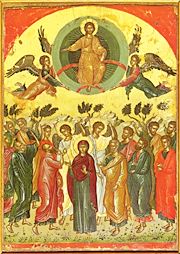Înălțarea Domnului
| Acest articol (sau părți din el) este propus spre traducere din limba engleză!
Dacă doriți să vă asumați acestă traducere (parțial sau integral), anunțați acest lucru pe pagina de discuții a articolului. |
The Ascension of Jesus Christ is one of the Great Feasts of the Orthodox Church, celebrated forty days after Pascha (and thus always falling on a Thursday -- see Paschalion).
Forty days after the Resurrection, while blessing His disciples (Gospel of Luke 24:50-51), Christ ascended into heaven, taking His place at the right hand of the Father (Gospel of Mark 16:19 and Nicene-Constantinopolitan Creed).
Referinţe Scripturale
The first account of the Ascension found in the Bible is in the Gospel of Mark (16:14-19). The description is brief. Jesus and the remaining eleven Disciples are seated at a table, presumably in a room in or near Jerusalem. Jesus commands his followers to spread the Gospel, and that those who believe will be known by their invulnerability to poison, ability to heal the sick, and the like. After delivering these final words, Jesus is received into Heaven to sit at the right hand of God. No description of the Ascension itself is given; Mark simply states that it happened.
The Gospel of Luke is even more brief in its description (24:50-51). Jesus led the eleven to Bethany, not far from Jerusalem. While in the act of blessing them, Jesus was carried up to Heaven.
The third, and most celebrated, account of the Ascension is in the Acts of the Apostles (1:9-12). For forty days after the Resurrection, Jesus continued to preach the Gospel. Jesus and the eleven were gathered near Mt. Olivet (or the Mount of Olives), to the northeast of Bethany. Jesus tells his disciples that they will receive the power of the Holy Spirit and that they will spread his message the world over. Jesus is taken up and received by a cloud. Some traditions say that he was taken up in a fiery chariot, much like the Prophet Elijah. Two men clothed in white appear and tell the disciples that Jesus will return in the same manner as he was taken. They say: "Ye men of Galilee, why stand ye gazing up into Heaven? This same Jesus, Who is taken up from you into Heaven, shall so come in like manner as ye have seen Him go into Heaven"1 (Acts 1:11). Afterwards the disciples return to Jerusalem rejoicing, remaining continually in the Temple.
The Gospel of Matthew ends at a mountain in Galilee, with Jesus commanding the Disciples to spread the Gospel. No mention of the Ascension is made.
Importanţă
The Ascension of Christ shows the last stage in God's plan for mankind: total union with Himself upon one's departure from the world. According to OCA, "in the Ascension resides the meaning and the fullness of Christ's Resurrection....and with Christ, man's nature ascends also."
Imnografie
- O Christ God, You have ascended in Glory,
- Granting joy to Your disciples by the promise of the Holy Spirit.
- Through the blessing they were assured
- That You are the Son of God,
- The Redeemer of the world!
Kontakion (Tone 6)
- When You did fulfill the dispensation for our sake,
- And unite earth to Heaven:
- You did ascend in glory, O Christ our God,
- Not being parted from those who love You,
- But remaining with them and crying:
- I am with you and no one will be against you
See also
Source and External Links
- wikipedia:Ascension
- GOARCH:Ascension
- OCA:The Ascension of Our Lord
- Format:Note Scripture taken from the King James Version of the Bible. See Acts Chapter 1
- Icons of Ascension
